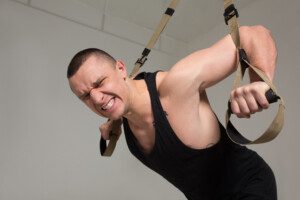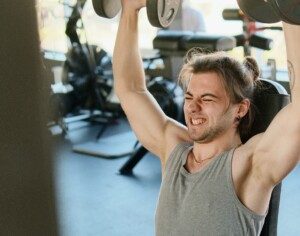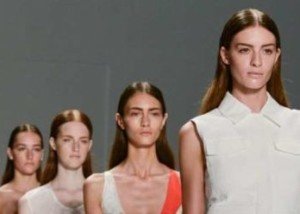Do you wrinkle up your face while lifting heavy weights or straining for those last few reps? You’re trading smooth skin for a sculpted physique.
You might think it’s necessary to scrunch up your face and crinkle the skin around your eyes in order to complete your intense strength training routines.
This will cause premature wrinkling of your skin that won’t magically go away.
Look at photos of bodybuilders and physique competitors on stage or posing for exercise routines.
Many have road maps on their faces. This includes the women. They have many lines and sometimes deep creases, yet are only in their 30s and even 20s.
“Muscles of facial expression wrinkle and fold the skin,” says Dina D. Strachan, MD, a board certified dermatologist, and founder/director of Aglow Dermatology in Manhattan, NY.
“Just like with paper or fabric, the more something is folded, the more the fold remains even when the surface is relaxed,” continues Dr. Strachan.
“Your grandmother was right: When you make certain expressions, your face does start to stay that way.
“As we age, we lose collagen and elastin that allows our skin to snap back after folding.
“Babies get wrinkles when they make expressions, but their collagen-rich skin snaps back.
“Over time, our skin is less forgiving of expressions like grimacing and frowning, and we develop wrinkles.”
I began lifting weights at 15, and have never stopped. I believe it was in college when I noticed that many men in the campus weightlifting room grimaced like mad for heavy lifts – the bench press, the seated shoulder dumbbell press, the pull-down, the leg extension.
As a young adult I noticed the array of wrinkles, crinkles, creases and grooves on the faces of bodybuilders and physique athletes all lined up on stage – as shown in magazines.
You can also easily see this online as well, and also in person. I knew early on never to grimace or “make faces” when straining with heavy weight.
The exercises that seem to bring this out the most at any given gym are the deadlift, back squat, bench press, dumbbell press and leg press.
However, you’ll see grimacing even with biceps curls and triceps push-downs. It’s prevalent.
But is it necessary?

Freepik.com/LipikStockMedia
I’ve been lifting heavy for years with almost no grimacing or “faces.” For the most part I maintain a stone or Vulcan face, though my eyes may glare.
However, I’ll admit, I’ve grimaced with the deadlift. It’s impossible to avoid wrinkling up your face with your heaviest pulls. Same with bench dips with 90 pounds on your lap (yes, I’ve done that).
If you’re a younger muscle-building enthusiast and wondering if it’s worth it to keep a straight face while lifting, I say YES!
I hardly have any wrinkles. I’m absolutely without a doubt very sure that if I’d been scrunching up my face all these years at the gym, I’d have plenty of lines and wrinkles to show for it – without being stronger or more muscular.
I’m not saying hold a straight face during training for a powerlifting competition, let alone at the competition.
But ask yourself if contorting your face is really necessary for the preacher curl, side dumbbell lift, leg curl, leg extension and cable work.
You can actually train your face not to move while executing your heaviest flat or incline bench press.
If you feel it’s impossible not to make faces while lifting heavy, at least try to avoid it first with isolation work, then move on from there.
Treatments for Wrinkles from Lifting Weights
If you already have a face full of lines and creases from years of grimacing during weight workouts, there are several things you can do besides abolishing this habit so that the wrinkles don’t get worse.
Dr. Strachan says, “Sunscreen can help mitigate the effects of wrinkles from facial expression by slowing down the loss of collagen and elastin from sun damage.
“Botox and other neurotoxins are the go-to treatment for wrinkles caused by facial expression. It works by relaxing the muscle so there is less creasing of the skin.
“Radiofrequency (rf) and rf microneedling treatments, as well as laser, chemical peels and topical retinoids, can also improve the skin’s recovery from constant folding.”
 Dina D. Strachan, MD, is a board certified dermatologist, consultant and speaker in New York City. She is the founder and director of Aglow Dermatology, an independent medical and cosmetic dermatology practice in Manhattan. Follow her on Instagram and LinkedIn @drdinamd.
Dina D. Strachan, MD, is a board certified dermatologist, consultant and speaker in New York City. She is the founder and director of Aglow Dermatology, an independent medical and cosmetic dermatology practice in Manhattan. Follow her on Instagram and LinkedIn @drdinamd.
 Lorra Garrick has been covering medical, fitness and cybersecurity topics for many years, having written thousands of articles for print magazines and websites, including as a ghostwriter. She’s also a former ACE-certified personal trainer.
Lorra Garrick has been covering medical, fitness and cybersecurity topics for many years, having written thousands of articles for print magazines and websites, including as a ghostwriter. She’s also a former ACE-certified personal trainer.
.










































